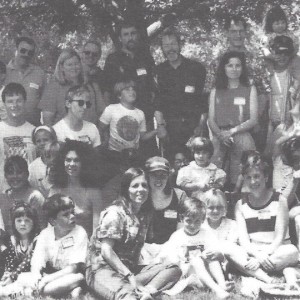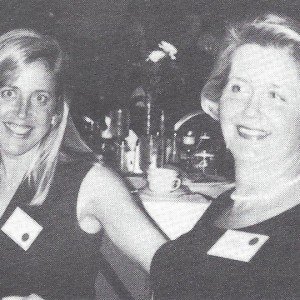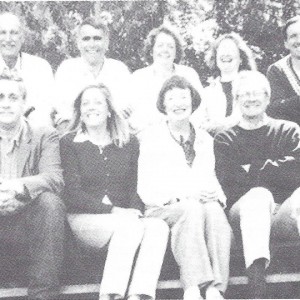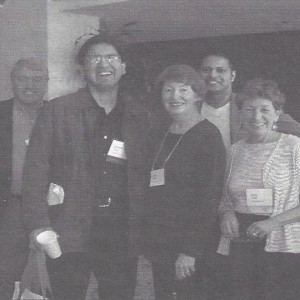Looking Back…Moving Forward: One Vision Built on Determination
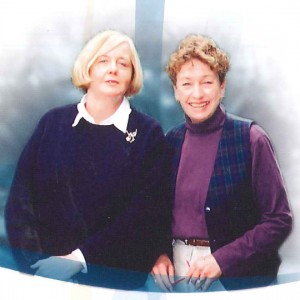 2013 is the 30th anniversary of the beginnings of our association. To help us commemorate this important landmark, we will feature a series of interviews with members from our community, including members of our board of directors, our medical advisory board, our volunteer network, our scientific community, and, of course, our founding members. We hope that you enjoy these intimate and conversational pieces for both their educational content as well as their historical perspective.
2013 is the 30th anniversary of the beginnings of our association. To help us commemorate this important landmark, we will feature a series of interviews with members from our community, including members of our board of directors, our medical advisory board, our volunteer network, our scientific community, and, of course, our founding members. We hope that you enjoy these intimate and conversational pieces for both their educational content as well as their historical perspective.
By stepping back in time, we hope that the voices of these individuals will help you share in the challenges, the triumphs, and the special memories that comprise the heart behind the work of our association.
This week we sit down with two of our founding members, Emily Fudge and Cynthia Solomon, to discuss the early days of forming the association, including their vision and their challenges.
HA: How did the two of you meet and what drove you in those early days to begin working together to form what would become the Hydrocephalus Association?
EMILY: When our sons were diagnosed with hydrocephalus (my son Gerard was 11 and Cynthia’s son Alex was 7), there was nothing out there for patients or their families. There was one small organization in Brooklyn, New York – The Guardians of Hydrocephalus Research Foundation – but they offered little in the way of educational materials.
CYNTHIA: Our common denominator was Michael Edwards [pediatric neurosurgeon at the University of California San Francisco (UCSF)]. Michael put up money and space to bring families together to talk. I met Emily at one of the very first meetings at USCF in a room Michael had set aside. That was the beginning of the Hydrocephalus Association. Both Emily and I had sick kids and we kept running into each other at UC. The commonality was frustration as mothers and not getting answers. The kids would get hospitalized and we wouldn’t leave them. The doctors and nurses were not good at answering questions.
EMILY: There was no place to go – no internet and no statistics. We tried to find statistics on outcomes for people with hydrocephalus but they weren’t available because hydrocephalus did not have an ICD code and therefore it was not searchable. What was coded was the primary condition, such as spina bifida or cerebral palsy.
CYNTHIA: I was married to a doctor at the time and I had access to medical books, etc. but the information on hydrocephalus was very negative. As the organization came together, Emily and I shared the strategy of developing more information and knowledge. We came at it from a more personal viewpoint: mothers of sons with hydrocephalus. We realized how important outreach was and that talking with and networking with other families felt productive. One Saturday a month we would organize a meeting with a speaker and invite other parents to join us. But my reason for being involved in the organization was to find the best surgeons, best doctors, and best information so Alex, my son, would have a fighting chance. If we got to do something and create something and be a part of something, then it was so we could keep our kids okay.
HA: What were your priorities?
EMILY: We had a couple of priorities in those early days. First, we needed to meet other people and get support. Second, we needed information. We realized that as parents we were out here in the dark. We felt that someone needed to be interviewing doctors, doing research and writing down information. Since no one else was doing it, we decided that it had to be us.
HA: In 1986, About Hydrocephalus – A Book for Parents was published.
EMILY: About Hydrocephalus began as the Masters project of a UCSF student in medical illustration. A number of our families were interviewed and photographed during the research process. Once it was published, UCSF gave us the rights to sell and distribute the booklet. We didn’t make a profit but the booklet paid for itself.
HA: At this point you had a small group formed, you were meeting, and you had published a book on hydrocephalus. You also had a vision for where you wanted the association to go. What were some of the challenge you faced in those early years?
EMILY: Cynthia and I understood that doctors were people too and that we had to get to the doctors and talk to them–let them know that kids with hydrocephalus were not to be thrown away, that they were real people. To many doctors, treating hydrocephalus was just a plumbing problem. The outcomes for many patients at the time were not optimistic, though we knew children who were having good outcomes. We wanted to get the doctors to understand that our kids were living, they had quality of life. We were confident that even more children could have a better outcome if there was recognition within the medical community that with appropriate intervention and related services, this was possible. This was the real challenge for us.
CYNTHIA: Michael [Edwards] helped get a booth for us at the AANS [American Association of Neurological Surgeons] annual meeting in Seattle. We got the table last minute and there were no hotels left. The only hotel left was a sketchy hotel where we were scared to sleep in the beds. We went to the meeting for one day and sat at a table that said Hydrocephalus Association.
EMILY: The only thing we had at our table was About Hydrocephalus – A Book for Parents, the first real resource ever published specifically to educate parents. It may be hard for parents today to understand because now they can call HA and get a wealth of resources. But back in the 1980’s, this was not the case.
CYNTHIA: The nurses and doctors would come by the table and stop and talk in front of us as if we weren’t there, saying “Oh, this is such a terrible condition.”
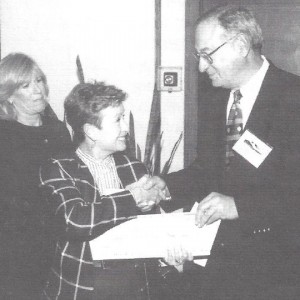
Emily accepts donated award prize from Medtronic PS Medical Robert H. Pudenz annual award recipient, Harold D. Portney, M.D., 1999
EMILY: Some doctors would come up to the table, realize we were parents, and walk away. We tried standing in front of the table and stopping the doctors. They would say, “Oh those poor, poor kids. It’s such a tragic thing.” We would say, “We both have sons with hydrocephalus and they’re doing okay.” They would shake their heads and walk away.
We were very lucky, though, because the neurosurgeon who served our kids steered us to some really good people like Fred Epstein, the head of pediatric neurosurgery at New York University. He had written an article for a pediatric journal entitled The Impossible Dream that talked about kids with hydrocephalus and how you can’t just put in a shunt and say goodbye and let them go. They would be under your care forever and ever.
CYNTHIA: Our presence at the meeting was new for us, but it was also new for the physicians, too. They didn’t want to talk to patients. The attitude then was that patients were too stupid to know or understand; and that talking to patients would take up way too much time.
EMILY: When we found the organization of pediatric neurosurgeons, we felt like we were home. We felt that these doctors had to be special people because who wants to deal with kids with hydrocephalus? They were very concerned about the quality of life for kids with hydrocephalus. When we went to their conference in Phoenix in 1988, we were allowed to attend their professional sessions. We walked into a room and they were talking about shunt revisions and problems. Alexa Canady [the first African-American woman neurosurgeon] stood up and she said to her colleagues, “You know, folks, there’s more to hydrocephalus than just all the revisions and shunts not working.” Then she brought up the concerns of long-term quality of life. Cynthia and I almost fell off our chairs.
CYNTHIA: Hal Rekate, MD had his entourage of residents and doctors following him around at this meeting. Initially we were totally ignored. But then he came by our table and told us how important our work was. Just by stopping and talking to us, he gave everyone else encouragement to come by. When Hal came by our table, it was like being crowned, and after that we couldn’t keep people away from our table.
EMILY: The docs loved us. They didn’t have any educational materials to give their patients, so they were great about passing out our information. They were excited that they finally had something they could give to their patients.
When they realized they were just as concerned as we were about these kids and their futures, we were able to form a partnership. The challenge we met successfully was forming this collaborative relationship with doctors.
CYNTHIA: The meeting was a key defining moment. This type of partnership didn’t really exist at the time with any medical condition. What they learned is that if you give patients the time and information and resources, you’ll spend less time with them overall because the more we know, the less fearful we are. HA became a translator across the healthcare paradigm because in those days, doctors did not talk to patients.
HA: What would you say some of the other key moments or accomplishments are of HA?
CYNTHIA: In the early days, there were a lot of battles for parents not accepting the status quo and having to push. It bothered me that nurses didn’t like me but it gets to the point where you don’t care. Your kid’s life is on the line. The doctors thought you were crazy. But parents know their child best. When parents learn not to panic and trust their instincts, then they are better able to advocate for their child and teach their children how to advocate for themselves. I do believe that we were one of the very first organizations to teach advocacy.
EMILY: People with hydrocephalus were totally alone and had no information. The key was we connected people, and educated ourselves and others with the help of the doctors.
CYNTHIA: We worked hard to bring the best doctors on board and eventually the cream of the crop became our medical advisory board. We chose the first members of the board, but very soon, doctors wanted to be a part of the medical advisory board. It was an honor for them. It was a medical culture shift, I believe. I think that HA can feel very proud of its role in early patient engagement.
Our first patient/parent/professional conference was the first of its kind.
EMILY: We created a community where doctors talked to patients. The doctors came to our conferences. Seeing a patient talking to a neurosurgeon, one-on-one, at our conference was powerful. A neurosurgeon spent five minutes just talking to a family. 25 to 30 years ago many people were seeing adult-focused neurosurgeons and not pediatric neurosurgeons, so to see doctors talk to patients and their families and answer their questions was very meaningful.
HA: In the early years, you also had the insight to reach out to the shunt manufacturers to involve them as well.
EMILY: We always talked about community and to us it meant parents, professionals, and industry. When we started going to annual meetings, we were able to connect with the shunt manufacturers, too. Shunts were a small part of their business. Doctors were saying [these companies] needed to pay attention to us. By being at the meetings and having doctors say they get all their shunts from X company, that connected us with the sales people and business side of hydrocephalus. This is how I met Ralph Kistler, who was with PS Medical at the time, which is now Medtronic. He still serves on our board of directors today.
HA: Cynthia, you were the one to make the initial contact with Marvin Sussman, who has become an active and engaged member of the Association from its inception, as well. How did you bring him onboard?
CYNTHIA: Marvin used to be a vice president with Cordis, a shunt manufacturer. Alex had had many surgeries because his shunt kept failing. I was mad at the world and trying to figure out what to do and where to go. I called Cordis and said I needed to talk to someone because I didn’t understand how these shunts worked because it was not working on my kid. They transferred me to Marvin who spent a lot of time on the phone with me and sent me a packet of information on shunts, how they work and what they do. He went on to create wonderful ideas for us. It was his idea for me to fund the Resident’s prize.
It seemed like we would reach out and we were able to get people on board. What fueled us was the fact that we didn’t want to lose the kids.
HA: Where do you see HA five years from now?
EMILY: First, to continue to be on the forefront of researching and publishing first class, cutting edge information on hydrocephalus, shunts, and where the field is going. If someone wants an answer to a question or needs technical information, they go to HA.
Second, we need to continue to provide one-on-one support. You can’t duplicate a personal phone conversation. Sitting down and talking over the phone to a family or meeting them in person is still crucial. HA needs to continue to provide the best personal support we can, using all types of tools.
Third, focus on the first generation of children shunted for hydrocephalus that are now adults. HA needs to continue to involve this generation, to empower them and educate them. TTC [Teens Take Charge] is crucial for the next generation’s well-being and quality of life. HA needs to develop programs to sustain their involvement as they grow.
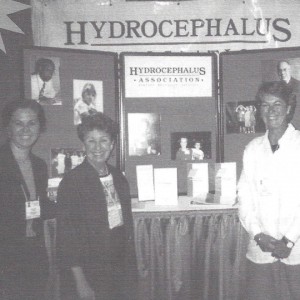
Jennifer Henerlau, Emily, and Pip Marks, Annual Meeting of the Congress of Neurological Surgeons, Philadelphia, PA, 2002
Fourth, I would love to see a lot more money for research – interdisciplinary research. I remember hearing a talk by a doctor who was a glaucoma specialist and hearing her discuss possible connections with hydrocephalus.
CYNTHIA: I’m so proud of what the organization has become and all the wonderful work that has been accomplished since I’ve been gone. I think it’s on the right path. I think, given the way healthcare is going and the competition for research dollars, we’re not going to be able to rely much longer on NIH. We’re competing with so many conditions. I think the changes in how hydrocephalus is treated will come out of the research and the drive of HA. I don’t think it will be one scientist here or one medical school there, but that the HA will create collaboration and coordination of all the research going on and the best practices and it will define, in the future, the way hydrocephalus should be treated and the management advances. Instead of being reactive, we’ve come full circle where we have an organization that’s proactive. When we talk about consumer-centric healthcare, the HA is the epitome of that.
Emily Fudge served as the Executive Director of the Hydrocephalus Association from 1989 to 2004. Her son Gerard was diagnosed with hydrocephalus in 1981 at the age of 11, spurring Emily and her husband Russell to be two of the founding members of the association. Gerard died in 1992. The first Hydrocephalus Association Scholarship was established in 1994 by the Fudge Family and their friends, in memory of Gerard.
Cynthia Solomon, a nationally recognized health advocate, founded FollowMe™ (2000), a consumer-centric public health record (PHR)/health information technology (HIT) provider for vulnerable populations. She cofounded the Hydrocephalus Association (1983) to help people like her son with hydrocephalus navigate healthcare issues. As a Markle Foundation Connecting for Health Workgroup member (2004), she helped develop recommendations/standards for electronic health records (EHR)/PHR interoperability submitted to the Office of the National Coordinator for Health Information Technology, (DHHS) “Connecting Americans to their Healthcare” (7/2004). She testified on PHR technology to the National Committee on Vital and Health Statics (NCVHS) National Health Information Infrastructure workgroup (4/2005) & the Consumer Empowerment Workgroup–American Health Information Community on Government’s role in PHR technology (5/2006) & the Presidential IT Commission on Interoperability (www.endingthedocumentgame.gov). She presented at the Institute of Medicine (IOM) Roundtable on Health Literacy (3/2008) & testified to the Office of National Coordinator (ONC) Policy Committee on Meaningful Use (6/2010) & the IOM Conference “Improving Health Literacy within a State “ (11/2010) In 2012. Ms. Solomon served on the ONC Health IT & Health Disparities Expert Panel (NORC). She received the California eHealth Spirit of Excellence Award (Nov 2012).

